Leaves scattered across the path in shades of gold and red, a crisp wind blowing, creating little piles of leaves next to rocks. And the rain - every few minutes, a drop, maybe three. The low, grey sky never decided what it wanted to do. Looking out my window, the mist is curling around the hilltops, purple in the distance, grazing the horizon. In Memphis, we'd call this winter.
0 Comments
Norway is serious about financial fraud. I mean REALLY REALLY serious. In order to open a bank account, you must first acquire your residency card AND a personnummer, or tax ID, even if you will not end up owing taxes. Of course, both of these things must be taken care of at different offices. I was required to go to Ski, a larger town a little further south than Kolbotn, and report to the police in order to get my residency card, by August 14. I did, on August 14. I showed the nice lady my passport, the official letter saying I am approved to live in Norway, my lease, and my letter of financial support from the Fulbright Foundation. Ja, ja, good good. Please sit and look into the screen. You will get your card in 2-3 weeks. *sigh* Back on the train.
I met another Fulbrighter on the train the next day. She also had gone to Ski and had heard a rumor that you could apply for your persononummer without the residency card as long as you had a letter from the police saying you had applied. Woohooo. Off we went to the Immigration Office. We waited for I don't even know how long. We both had all our paperwork. She had no problem - bing bang boom. applied for. You will get your number in 3-4 weeks. Me - well. The nice lady in Ski had not STAMPED the paper. SOOOO - I had to go back to Ski, get the paper stamped and come BACK to Oslo to apply for the number. OK. *sigh* Back on the train. Fast forward 3 weeks - I've been back to Ski, back to Oslo, filed my paperwork, just waiting for my cards. My nice landlady comes down with an envelope - woo hooo! Residency card! Surely the tax ID can not be far behind, then a bank account, and access to money so I can eat something other than sandwiches and ramen noodles. And then I looked at my card. My (terrible) picture, my signature, my address. And the name - Mark Julian Clementi. WHAT?! yes - I was now a transvestite alien. From Maryland. *bangs head on wall* sigh. Back on the train. The government workers at the police station in Ski are very nice. We've become quite close, really. They could not explain what happened. And felt very sorry for my having to come down again, in the pouring rain. It took 30 minutes to find the entry in a database and fix it. Please sit and look into the screen. Please do not drip water on the screen. Takk. You will get your card in 1 week. Will this in any way impact my application for a personummer? Oh no - our databases are not connected. *sigh* Back on the train. The card, which sports the worst picture ever taken of any living being, seriously, arrived within the week. No tax card. Days go by. No tax card. Then, an email from Heidi, at the tax office. "Hallo! Your were at the taxoffice in Oslo for registration in Norway August the 15. for registration in Norway, and to get a taxcard for 2012. We are sorry to inform you that we took a copy of the wrong residence permit. Please take contact vith us so we can get the correct copy." So much for non-connected databases. We apologize for the mix-up You will get your card by next week. *sigh* Back on the train. In my inbox yesterday-"Hei. Having already checked your case, but it is unfortunately not finished. Will be checking your case in more detail in the morning. But do not think you'll hear anything until next week." *sigh* 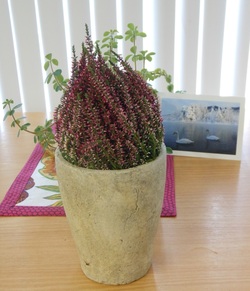 I spent Monday in Åmot, a little town about 1.5 hours west of Oslo, just past Drammen. (more about Drammen later.) I took the TIMEkspressen bus which left Oslo S at 7:20am. The route took us south through the city, a part of Oslo I had not seen before. We hugged the fjord for a while - I couldn't see much because it began raining fairly heavily. Eventually we passed through the last of the inner suburbs and crossed into much more rural areas - the fields were being cut for hay, bales scattered around, red barns dotting the hills. By the time we got to Drammen, a fairly large city by Norwegian standards (about the size of Monroe, Louisiana, for comparison) the rain had eased and I saw the most beautiful church near the city center. Nestled between two more modern buildings, with a striking, manicured garden in front, this magnificent arrangement of spires and steeples. I did a little research - it apparently is Bragernes church. I couldn't get a picture - I was in a bus that was moving - but I will definitely get one next time I am there. May have to borrow a wide angle lens in order to get the right shot.
The point of the trip, of course, was to visit Rosthaug Videregående Skole. I ended up teaching six classes. Many of the students were actually interested in hearing about the electoral college and others - well. yeah. It is the electoral college after all. My hosts and I discussed what they see as one of the greatest challenges in teaching at the VGS level, especially on the vocational side - the wide range of abilities present in a class. There were some who were fluent in English, confident in their speaking, and actively participating while there were others who simply did not have the fluency to understand more than a basic conversation and were too shy, or embarrassed, to speak in class, even to say their name. It makes it difficult to develop a lesson that engages the more advanced students while not overwhelming to others and further discouraging their interest in the subject. The last class of the day was Music as Politics for a small class of vocational track students, most of whom were in the agriculture program, all girls but for one boy. They were very very hesitant to talk. Except for the most unlikely student. She apparently is from Chile and is half Mapuche, one of the larger indigenous communities of Chile. She was positively thrilled to talk about Chile with me, and have me listen to her, and understand, her story. She was born with a severe hare lip and came to Norway for surgery as a child. Through some arrangement, she was left her with a family and lost contact with a part of her family in Chile. She has basically been shuffled between homes for around 10 years. She has now found her birth family again and hopes to be able to go see them next year after she has another surgery. She has faced bullying and ostracizing not simply for her disfigurement, but because of the color of her skin. It bothers her a bit, but she is so grateful to have been able to come to Norway, receive the medical care she needs, and an education. She told me all this, in her fourth language, with a still disfigured palette which prevents her from enunciating clearly. Wow. Her story really puts my stutter in perspective. p.s. Oh - the picture of the plant - the teachers liked me so much they went out at lunch and bought me a plant. I think it's heather. I'm going to try not to kill it. I think I utilized every type of public transport today, except ferry. But I'm sure that will happen eventually. It's actually neat to be able to travel all over the country fairly easily. They have regional buses which connect the smaller towns like Mosjøen to each other and to larger cities like Oslo and Trondheim. They remind me of Greyhound and Trailways - except people still use them. I especially like the trains. I've always loved trains and I get to ride on them all the time. WEEEEE! I know the northeast - Massachusetts, New York, et cetera - have substantial train systems. I wish the rest of the country did as well. I'd much rather jump on a train and read a book all the way to Augusta then drive through Alabama. Domestic air travel here is also extensive and relatively affordable! If you are a student, you get to fly half=price -
The trip went relatively well., I think. The class I spoke to yesterday eventually started asking questions and they actually had some pretty good ones. They were particularly mystified by the role of religion in our politics. As we do, they have a secular Constitution, although they do have a state religion. Perhaps it's never been an issue because their population was relatively homogenous compared to ours. What is interesting is the large influx of Muslim immigrants from North Africa and the Middle East is being offset by immigration from Poland and Eastern Europe. The Church of Norway (which is Lutheran) is shrinking, but Christianity on the whole is stable. Norwegian society seems so commented to equality, however, I don't see faith becoming a litmus test for their politicians - that would be the anti-thesis of their democratic ideal. But then again, I could be wrong. I've only been her five weeks! What do I really know? :) 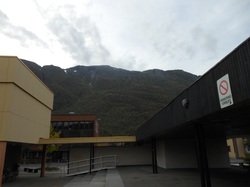 Well, I survived my first solo Roving visit. This is a view from Mosjøen VGS of the mountain which dominates the landscape. No matter where you turn - there's the mountain. And yes, the white spots are snow patches which didn't melt this summer. The cab driver last night said ti has been a cool summer and the snow usually melts. People also apparently climb this monster. *shudder* I'll admire it from the ground or from the air as I fly over it, thank you very much.
The faculty at the school were extremely nice. They had me come back this evening to talk to them about the American political system and the upcoming election, then answer random questions. Yes, it is my dream come true. In the Q&A, I was stunned not one person, NOT ONE, asked about Elvis. Perhaps his cultural cache' is fading? They did ask me about 9/11, Bush, Romney, Sarah Palin, and Americans' apparent general ignorance of the world outside our borders. The students wanted to know what I thought of Norwegian food (glad I like fish and it's soooooo expensive), what was the main difference between American and Norwegian high schools ( less structure here and more personal freedom for the students), how much beer cost in the US, and should pot be legalized. They are teenagers, after all,  Well, I will be in a few hours. I will be going to Mosjøen, which is about 45 minutes north of Trondheim. It's not a large town, less than 10,000 people, but it has an awesome coat of arms - see left. It's largest employer appears to be Alcoa, which has an aluminum plant in the area. It also contains the largest concentration of 19th century buildings in northern Norway and I'll be staying at the oldest hotel in northern Norway, the Fru Haugans Hotel, which dates to the late 1700s. I'll be there for a couple of days, speaking to both students and teachers. They have asked me to speak to the students about Music as Politics (shout out to Joshua - Woody's original This Land will be used!) and my childhood. The teachers would like hear about the development of our political system and the upcoming election. I'm very nervous, but hopefully all will go well and I won't say y'all too much. (Although - one of the curriculum objectives of their English courses is exposure to regional dialects, so technically, I'd be working towards a learning goal!)
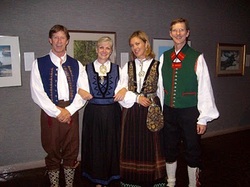 I awoke Saturday to the pealing of church bells. Not the taped versions that is so common in churches in the US now, but honest-to-God someone pulling on a rope pealing of bells. Kolbotn Kirke, or church, is Just down The Hill - I can see the steeple from my window on a clear day. It wasn't noon, or a Sunday, and there was no smoke, so I couldn't figure out why they were ringing the bells. Since it was essentially an alarm clock, I went ahead and got up and started puttering around. I noticed my landlords were gone and then remembered! One of their nieces was gettign confirmed. That must've been the reason for the bells! and then - CLANG CLANG CLANG! More pealing. OK - so they do it before and after the service. Ten minutes later - CLANG CLANG CLANG CLANG! huh. The pealing continued, off and on, for about an hour and a half. Best I can figure - they rang the bells after each child was confirmed. How do I deduce that and what does that have to do with the picture above? Glad you asked... I walked to the store a little later and noticed a group of girls standing in a driveway talking. It was obviously a party, cars parked everywhere, people mingling on the deck above. The girls, probably between 13 and 15, were all dressed in their new bunad, or traditional costumes, as the Norwegians say. Each area of the country has a distinct version and pattern, similar to the tartans of Scotland and Ireland in a way. You are only supposed to wear a version from a region to which you have a very strong link, such as family. They are worn on special occasions such as May 17 (Norwegian Constitution Day), weddings, baptisms, and (wait for it).... confirmations. In fact, according to this blog, many Norwegians, especially girls, receive their first bunad on their confirmations. I saw several lots of adults wearing them as well. That, of course, got me thinking. Why don't Americans have a traditional dress? The Irish and Scots have kilts, Indians have beautiful saris, the Japanese have the intricate kimono, the French have the beret. I would think that it's because of our immigrant heritage - no one is really FROM the US (Native Tribes excepted, of course) We, as a modern society, are such an amalgamation, it would be difficult to determine which "old country" to use as a model. My family has Irish, Scot, English, Belgian, and Native American that we know of. There may be more ... who knows. My husband is Irish, Scot, English, Prussian, Italian, and Native American. I'd prefer kilts - I love a nice plaid . Pat has already asked me to make him a kilt. But maybe Lizzie would prefer an Italian style - like this: If Americans did try to determine what it's national costume was, it would invariably involve a committee, consultants, action plans, powerpoints, and of course, a blind bidding process. We would then outsource the manufacturing of said national costumes to China.
I'm not quite sure what I ate for supper. It was frozen and I cooked it in my glorified toaster oven. The package said "fiskegrateng dypfryst" which translates to "frozen fish gratin." It wasn't bad, but still. Not what I was looking for. On the bright side, It was only a $1.
The other Rovers and I spent the day in Halden, visiting classrooms and chatting with teachers. The question we encountered most, form both students and teachers, was "Are Norwegian schools/students like American ones?" And I have to say, on the whole, yes. Certainly there are some structural and philosophical differences, but classroom dynamics, personalities, and even pedagogical techniques are remarkably similar. In fact, in one of the 8th grade English classes we sat in, I identified at least two ADHD students (not sure if they have the Norwegian equivalent of IEPs, but the teacher was well aware of the issue and very subtly manged the boys and their behavior. It was impressive, actually.) There was a potential "mean girl" in the back corner - physically more mature and definitely intelligent with a a very forceful personality who was skating a fine line between assertiveness and bullying. The teacher kept the kids engaged and active, while still maintaining control.
One difference I did notice was language. In all the classes, the teachers told the class what the objectives of the lesson were and then ASKED the students if they thought it could be achieved. If the students had said no, I doubt the lesson plan would have changed, but the idea that the students had some input, that their opinion of the not only the subject but the amount of material mattered on some level, was interesting. And I think that approach - seeing the students as autonomous participants with agency, however limited, is reflective of the underlying philosophical difference between American and Norwegian schools. Norwegian society, and government, see universal education as a fundamental right, the cornerstone of their democracy. Every child, every citizen is entitled to an equal education, financed at public expense. Education's primary purpose is not to feed qualified workers into the economy, but to build a sense of common purpose and shared civic values in order to build a more equitable and just society. Although several of the Founding Fathers saw education in that way - primarily Jefferson and Adams - I think that aspect has been sacrificed in pursuit of other goa |
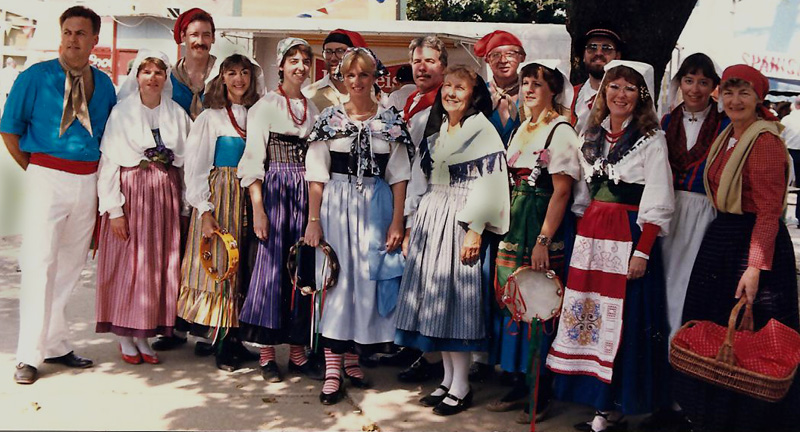
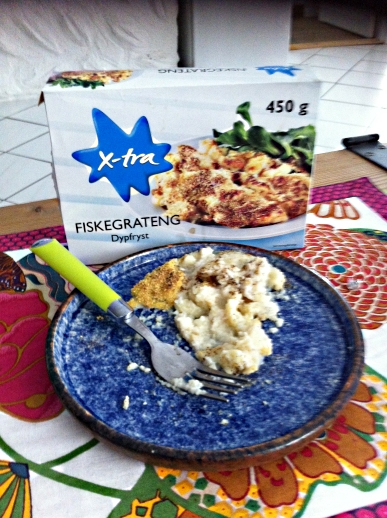
 RSS Feed
RSS Feed